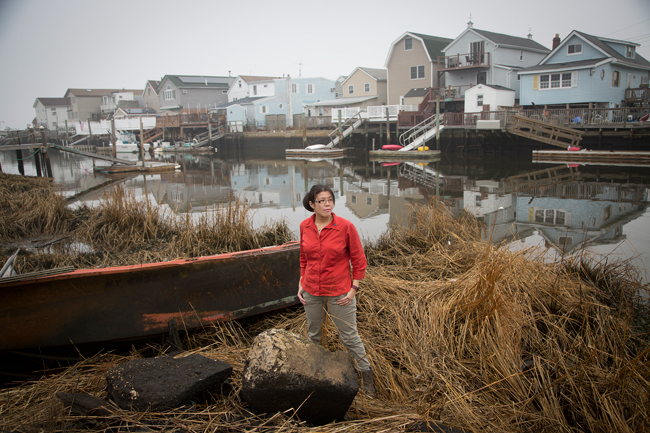
Helen Cheng, NYSG’s Jamaica Bay Coastal Resilience Specialist at SRIatJB. Credit: Jason Koski, Cornell University Photography
— By Paul C. Focazio, NYSG’s Interim Communications Manager
NOTE: For some post-climate forum analysis and ways in which you can best be prepared in the face of severe storms, see the two sections just below this article: "Are You Prepared" and "Before the Storm."
Brooklyn, NY, September 25, 2017—Five years post-Sandy, Helen Cheng says the superstorm “still looms in the memories of our stakeholders, but I’m looking forward to working with groups to help them prepare for coastal hazards and to be resilient for the next big storm.” Her next opportunity will be next week (Wednesday, September 27th, 2017), when the fourth in a series of New York City-based “Climate Forums”—each co-sponsored by New York Sea Grant (NYSG) and the Science and Resilience Institute at Jamaica Bay (SRI@JB)—will focus on hurricane preparedness.
The topic is an ever-so timely one, as forecasters from the National Oceanic and Atmospheric Administration (NOAA), Sea Grant's federal parent agency, announced their revised predictions in early August for the Atlantic hurricane season, which runs June 1st to November 30th. This included a higher likelihood of an above-normal season and thereby an increase in the predicted number of named storms and major hurricanes. At the time, NOAA reported that “the season has the potential to be extremely active, and could be the most active since 2010.”
According to inflation-adjusted estimates from NOAA, 20 storms causing a billion dollars or more in damage have taken place since 2010 (up through mid-August 2017’s Hurricane Harvey), compared with nine billion-dollar floods in the full decade of the 1980s. Seven have hit since 2016, including October’s Hurricane Matthew and February’s California flooding.
Cheng’s most recent forum will be held at the New York Aquarium in Coney Island, Brooklyn, which itself was closed for seven months after late-October 2012’s Superstorm Sandy hit. During that closure, the Aquarium’s 12,000 animals needed tending to, the power was restored and the buildings were secured and cleaned. The Aquarium, which is within NOAA’s Coastal Ecosystem Learning Center Network, will see a major part of its $151+ million rebuild—a new section called Ocean Wonders: Sharks—completed next summer.
In addition to NYSG and SRI@JB, presenters at this month’s forum will include the Consortium for Climate Risk in the Urban Northeast (CCRUN), NOAA’s National Weather Service and National Hurricane Center, NYC’s Office of Emergency Management and the Federal Emergency Management Agency. The night’s discussions will be followed by a "tools cafe," where in speakers and community residents will have an opportunity to interact, sharing resources and asking and answering questions.
Cheng says the overall objective of these forums is to establish a platform for dialogue and raise awareness by bringing scientists, decision-makers and community members together. “Our aim is to highlight climate change concerns and offer resources and tools that can help develop policies, strategies, programs and practices linked to flooding and other storm-related issues that these local communities in New York City face.”
Conversations will center on: How the current climate fuels the development of hurricanes; Updates on this year’s hurricane outlook; and how people respond to storm warnings. In regards to that last point, Cheng says it will be important to provide attendees with a step-by-step process of what to do when there is a hurricane warning, which was a hallmark of the recently-completed NOAA and Sea Grant-supported social science studies funded under the Coastal Storm Awareness Program.
In addition to starting up the climate forums in Fall 2016—a series with seasonal topical shifts—Cheng is helping NYC coastal communities grapple with the risks of coastal living and collaborating on restoration programs that aim to improve water quality and decrease erosion. Her podcast series, which provides an auditory perspective of Jamaica Bay, can be heard at www.srijb.org/jbpodcast or www.nyseagrant.org/jamaicabay.
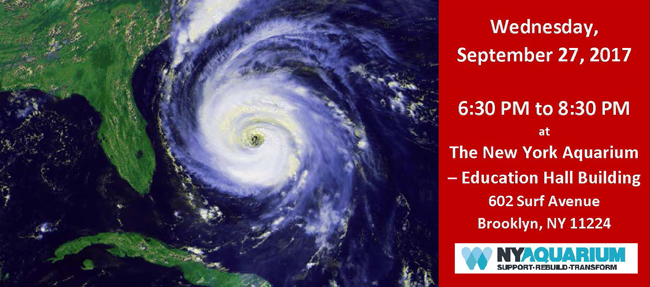
On YouTube: Senator Golden Asks, 'Are You Prepared for the Next Storm?' back to top
New York Senator Martin Golden from Senate District 22 offered some remarks at September 27, 2017's "Hurricanes and Hurricane Preparedness," the fourth in a series of Climate Forums that NYSG co-sponsored with the Science and Resilience Institute of Jamaica Bay. The event, held at the New York Aquarium in Coney Island, Brooklyn, was an effort to better inform the local community how hurricanes develop along the coast, what the outlook has been for hurricanes so far this season and ways in which NYC residents can prepare for severe storm situations.
In addition to community members and the evening's presenters - the Consortium for Climate Risk in the Urban Northeast (CCRUN), NOAA’s National Weather Service and National Hurricane Center, NYC’s Office of Emergency Management and the Federal Emergency Management Agency - a representative from Senator Roxanne Persaud's office from Senate District 19 also attended the interactive discussion.
"Houston, Florida, Louisiana and Puerto Rico are now dealing with disastrous effects of violent storms," said Golden in his remarks at the forum. "We can relate to this because five years ago Sandy devastated us ... and five years later we are still recovering."
"Through the devastation and hardship caused by Superstorm Sandy we learned that we must be prepared to protect ourselves and our property from future storms," Golden continued, citing the creation of a disaster plan so that you and your loved ones can figure out ways to communicate during an emergency is a positive step forward. Another is being aware of NYC's "Know Your Zone" campaign.
Before The Storm: Hurricane Preparedness back to top
Hurricanes are among nature’s most powerful and destructive phenomena. Hurricanes are most common during June 1 to November 30. Strong winds, waves, storm surge, flooding are a few of the many hazards that are associated with hurricanes.
New York City has experienced hurricanes and we have learned to increase our preparedness to these hazards.
One of the biggest concerns linked to severe storms: Storm Surge, which is flooding from water that is pushed onto land from the ocean as a hurricane approaches the shore. It can cause significant damage and threaten life and safety.
When a hurricane threatens a community, it is important for coastal residents to understand the risks from storm surge and know what to do to be safe. However, communicating storm surge risk is difficult because of the complex interactions between storms, coastlines, and communities.
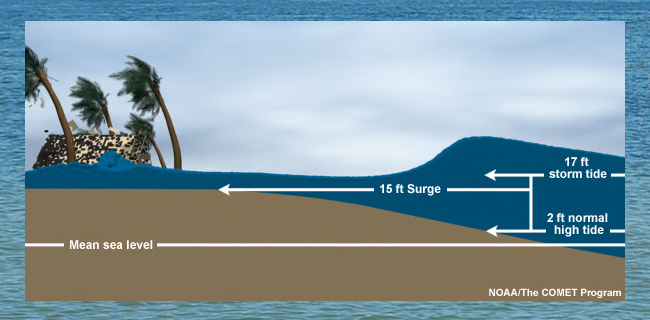
- Storm surge is caused primarily by the strong winds in a hurricane or a strong storm.
- Storm surge is an abnormal rise of water generated by a storm, over and above the predicted astronomical tide.
- Storm tide is the water level rise during a storm due to the combination of storm surge and the astronomical tide.
Here are some tips to keep you and those in your life safe ...
First, FEMA encourages you to be aware ...
Second, Sea Grant and SRIatJB offer you some recommendations on preparation ...
- Keep a battery-operated AM/FM radio tuned to a local station and follow emergency instructions.
If it is safe to evacuate, take your Go Bag with you.
- If you're caught inside by rising waters, move to a higher floor. Take warm clothing, a flashlight, and portable radio with you. Wait for help. Do NOT try to swim to safety.
- When outside, avoid walking and driving through flooded areas. As few as six inches of moving water can knock a person over. Six inches of water will reach the bottom of most passenger cars, causing loss of control and possible stalling. One or two feet of water can carry away a vehicle.
- If you have to walk in water, walk where the water is not moving or use a stick to check the firmness of the ground in front of you.
- Stay out of any building if it is surrounded by floodwaters.
If time permits:
- Turn off all utilities at the main power switch and close the main gas valve if evacuation appears necessary.
- Do not touch any electrical equipment unless it is in a dry area, or you are standing on a piece of dry wood while wearing rubber-soled shoes or boots and rubber gloves.
- Fill bathtubs, sinks, and jugs with clean water in case regular supplies are contaminated (you can sanitize these items by first rinsing with bleach).
- Board up windows or protect them with storm shutters or tape (to prevent flying glass).
- Bring outdoor objects, such as lawn furniture, garbage cans and other loose items, inside the house or tie them down securely.
Visit New York City Emergency Management Web site for more information.
Severe Storms: Sea Grant on Some Lessons Learned
2012: Superstorm Sandy (New York, New Jersey and Connecticut Sea Grant programs)
The 4-1/2 minute trailer for NOAA Sea Grant's Coastal Storm Awareness Program's 23-minute documentary, view-able on YouTube.
The key to CSAP, a $1.8M suite of 10 social science projects administered by Sea Grant programs in New York, New Jersey and Connecticut, is to help better understand how people respond to coastal storm warnings. "These storms will not go away," says NYSG Director Bill Wise. "They are likely to increase and, perhaps, become even more severe on average with global warming."
Findings from these 18-month community-based investigations are detailed in the recent news item "NOAA Sea Grant Coastal Storm Awareness Program Comes Ashore."
For more on NOAA Sea Grant's Coastal Storm Awareness Program see www.nyseagrant.org/csap.
2016: Hurricane Matthew (Georgia Sea Grant)
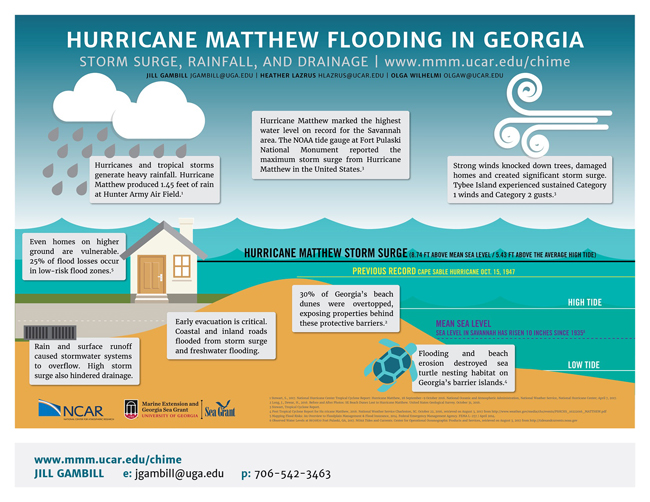
The infographic above will be shared in outreach throughout the affected
communities so that residents can make informed decisions when facing
future threats.
In late October 2016, NOAA declared Hurricane Matthew a record-breaking flood event, one which caused extensive flooding from storm surge and precipitation along the Atlantic coast, from Haiti to Canada, killing 603 people (47 in the United States) and causing over $15 billion worth of damage.
To understand how to best communicate storm surge risks, a team of researchers from the National Center for Atmospheric Research and the University of Georgia conducted seven focus groups in June 2017 with residents of three communities in Georgia and South Carolina that were affected by Hurricane Matthew. Participants of the focus groups included those from diverse communities in Beaufort, South Carolina and both Brunswick and Savannah, Georgia.
One initial finding of this project is the need for accurate and easy-to-understand information on the causes and extent of flooding during severe storm events. These visualizations attempt to explain the data from Hurricane Matthew and tell the story of how interactive and compounding flood risks can compromise personal safety.
Georgia Sea Grant (GASG), produced the “Reduce Your Hurricane Risk” video below, which contains critical hurricane messages that were identified in the focus groups as knowledge gaps or key motivators. The video is accessible for the vision impaired, deaf and hard of hearing ...
Additionally, GASG provided its residents with a variety of resources, including a series of images sharing key hurricane safety messages.
Here are about a half dozen of those tips, which the program shared via social media as part of its education on severe storms ...
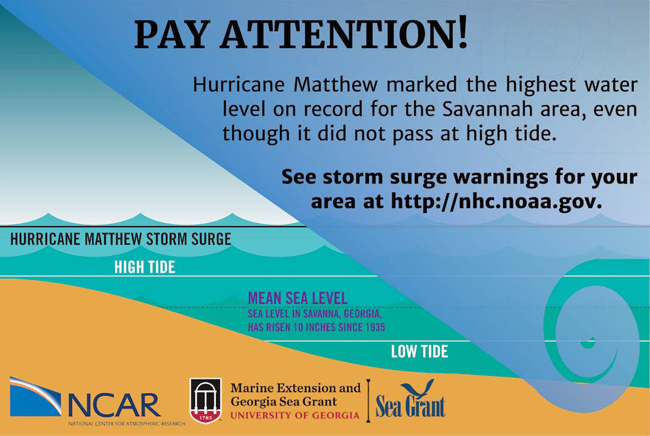
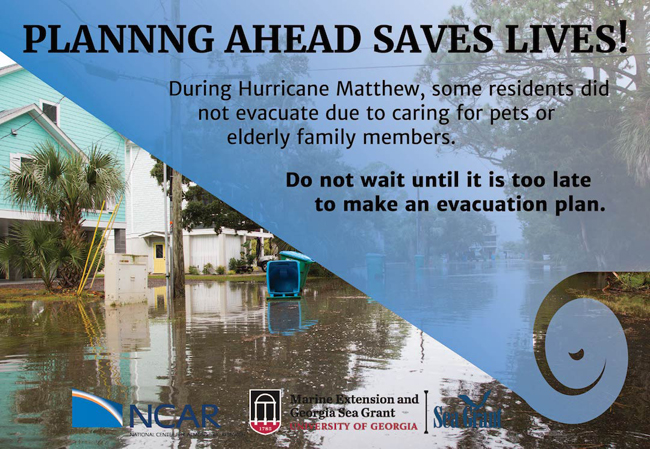
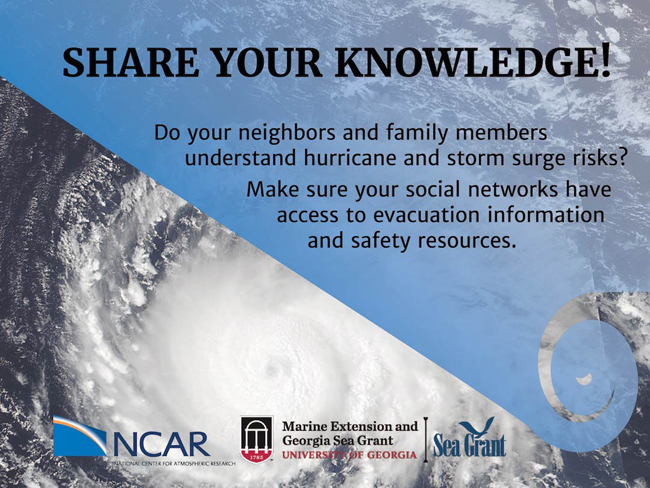
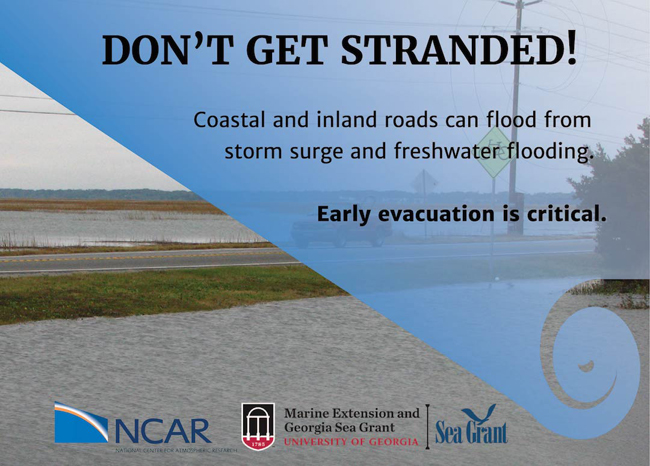
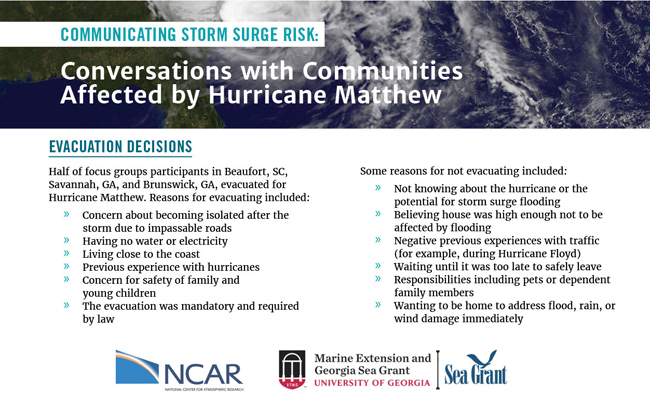
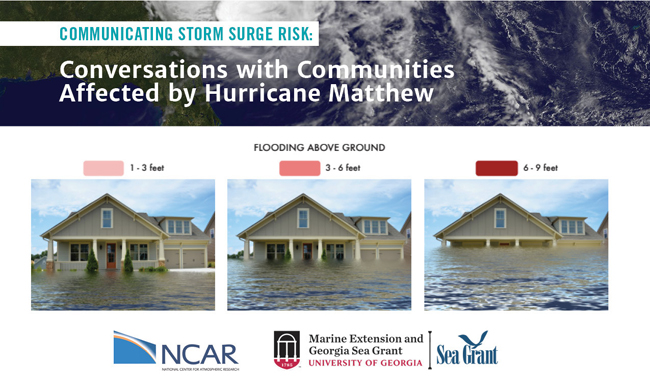
More Info: New York Sea Grant
New York Sea Grant (NYSG), a cooperative program of Cornell University
and the State University of New York, is one of 33 university-based
programs under the National Sea Grant College Program (NSGCP) of the
National Oceanic and Atmospheric Administration (NOAA). The NSGCP
engages this network of the nation’s top universities in conducting
scientific research, education, training and extension projects designed
to foster science-based decisions about the use and conservation of our
aquatic resources. Through its statewide network of integrated
services, NYSG has been promoting coastal vitality, environmental
sustainability, and citizen awareness about the State’s marine and Great
Lakes resources since 1971.
New York Sea Grant maintains Great Lakes offices at SUNY Buffalo, the
Wayne County Cooperative Extension office in Newark and at SUNY Oswego.
In the State's marine waters, NYSG has offices at Stony Brook University
and Stony Brook Manhattan, in the Hudson Valley through Cooperative
Extension in Kingston and at Brooklyn College.
For updates on Sea Grant activities: www.nyseagrant.org has RSS, Facebook, Twitter, and YouTube links. NYSG produces a monthly e-newsletter, "NOAA Sea Grant's Social Media Review," via its blog, www.nyseagrant.org/blog. Our program also offers a free e-list sign up via www.nyseagrant.org/coastlines for its flagship publication, NY Coastlines/Currents, which is published 1-2 times a year.